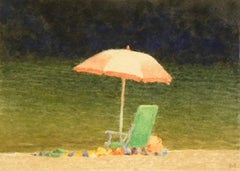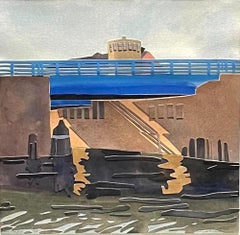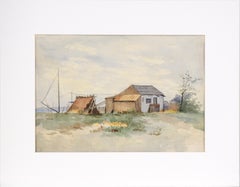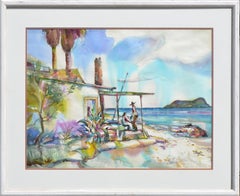Canopy Landscape Drawings and Watercolors
to
2
Overall Width
to
Overall Height
to
2
2
1
1
123
2,719
1,648
1,308
1,053
841
783
767
636
610
513
503
486
400
358
325
272
265
236
224
2
2
1
1
1
2
Art Subject: Canopy
Pink Umbrella. Green Chair
Located in Burlingame, CA
Serene river scene watercolor from important Bay Area figurative contemporary artists Mary Robertson, who is associated with the Bay Area Figurative School, founded by Elmer Bischoff...
Category
2010s American Impressionist Landscape Drawings and Watercolors
Materials
Paper, Watercolor
Hamilton Avenue
Located in Fairfield, CT
Having worked from a studio in the Gowanus area of Brooklyn for two decades, Elizabeth O'Reilly is at home in the abandoned precincts of the canal with its solidly geometric shapes. ...
Category
21st Century and Contemporary Impressionist Landscape Drawings and Water...
Materials
Watercolor
Related Items
Whalers Shack on the Northern California Coast - Watercolor Seascape
Located in Soquel, CA
Serene depiction of a Whaling shack circa 1900 near Davenport, California attributed to Lillian Josephine (Dake) Heath (19th century). Monogram on Verso "J. H. 1900".
Dated and initialed on verso "J. H. Feb. 1900"
Presented in a new white mat with foam core backing.
Mat size: 14"H x 18"W
Paper size: 9.25"H x 13.25"W
Lillian Heath was one of the Jolly Daubers at the turn of the 19th-century and as a young student, married the senior artist and instructor, Frank Heath...
Category
Early 1900s American Impressionist Landscape Drawings and Watercolors
Materials
Watercolor, Archival Paper
House at the Beach, Baja California Figurative Landscape
Located in Soquel, CA
Colors of tropical waters create a light and breezy mood in this figurative landscape watercolor by David Stephens (American, 20th century). Signed lower left, "D. Stephens." Present...
Category
1990s American Impressionist Landscape Drawings and Watercolors
Materials
Watercolor, Archival Paper
H 29.5 in W 37.5 in D 0.88 in
"Train Station, " Max Kuehne, Industrial City Scene, American Impressionism
By Max Kuehne
Located in New York, NY
Max Kuehne (1880 - 1968)
Train Station, circa 1910
Watercolor on paper
8 1/4 x 10 1/4 inches
Signed lower right
Provenance:
Private Collection, Illinois
Max Kuehne was born in Halle, Germany on November 7, 1880. During his adolescence the family immigrated to America and settled in Flushing, New York. As a young man, Max was active in rowing events, bicycle racing, swimming and sailing. After experimenting with various occupations, Kuehne decided to study art, which led him to William Merritt Chase's famous school in New York; he was trained by Chase himself, then by Kenneth Hayes Miller. Chase was at the peak of his career, and his portraits were especially in demand. Kuehne would have profited from Chase's invaluable lessons in technique, as well as his inspirational personality. Miller, only four years older than Kuehne, was another of the many artists to benefit from Chase's teachings. Even though Miller still would have been under the spell of Chase upon Kuehne's arrival, he was already experimenting with an aestheticism that went beyond Chase's realism and virtuosity of the brush. Later Miller developed a style dependent upon volumetric figures that recall Italian Renaissance prototypes.
Kuehne moved from Miller to Robert Henri in 1909. Rockwell Kent, who also studied under Chase, Miller, and Henri, expressed what he felt were their respective contributions: "As Chase had taught us to use our eyes, and Henri to enlist our hearts, Miller called on us to use our heads." (Rockwell Kent, It's Me O Lord: The Autobiography of Rockwell Kent. New York: Dodd, Mead and Co., 1955, p. 83). Henri prompted Kuehne to search out the unvarnished realities of urban living; a notable portion of Henri's stylistic formula was incorporated into his work.
Having received such a thorough foundation in art, Kuehne spent a year in Europe's major art museums to study techniques of the old masters. His son Richard named Ernest Lawson as one of Max Kuehne's European traveling companions. In 1911 Kuehne moved to New York where he maintained a studio and painted everyday scenes around him, using the rather Manet-like, dark palette of Henri.
A trip to Gloucester during the following summer engendered a brighter palette. In the words of Gallatin (1924, p. 60), during that summer Kuehne "executed some of his most successful pictures, paintings full of sunlight . . . revealing the fact that he was becoming a colorist of considerable distinction." Kuehne was away in England the year of the Armory Show (1913), where he worked on powerful, painterly seascapes on the rocky shores of Cornwall. Possibly inspired by Henri - who had discovered Madrid in 1900 then took classes there in 1906, 1908 and 1912 - Kuehne visited Spain in 1914; in all, he would spend three years there, maintaining a studio in Granada. He developed his own impressionism and a greater simplicity while in Spain, under the influence of the brilliant Mediterranean light. George Bellows convinced Kuehne to spend the summer of 1919 in Rockport, Maine (near Camden). The influence of Bellows was more than casual; he would have intensified Kuehne's commitment to paint life "in the raw" around him.
After another brief trip to Spain in 1920, Kuehne went to the other Rockport (Cape Ann, Massachusetts) where he was accepted as a member of the vigorous art colony, spearheaded by Aldro T. Hibbard. Rockport's picturesque ambiance fulfilled the needs of an artist-sailor: as a writer in the Gloucester Daily Times explained, "Max Kuehne came to Rockport to paint, but he stayed to sail." The 1920s was a boom decade for Cape Ann, as it was for the rest of the nation. Kuehne's studio in Rockport was formerly occupied by Jonas Lie.
Kuehne spent the summer of 1923 in Paris, where in July, André Breton started a brawl as the curtain went up on a play by his rival Tristan Tzara; the event signified the demise of the Dada movement. Kuehne could not relate to this avant-garde art but was apparently influenced by more traditional painters — the Fauves, Nabis, and painters such as Bonnard. Gallatin perceived a looser handling and more brilliant color in the pictures Kuehne brought back to the States in the fall. In 1926, Kuehne won the First Honorable Mention at the Carnegie Institute, and he re-exhibited there, for example, in 1937 (Before the Wind). Besides painting, Kuehne did sculpture, decorative screens, and furniture work with carved and gilded molding. In addition, he designed and carved his own frames, and John Taylor Adams encouraged Kuehne to execute etchings. Through his talents in all these media he was able to survive the Depression, and during the 1940s and 1950s these activities almost eclipsed his easel painting. In later years, Kuehne's landscapes and still-lifes show the influence of Cézanne and Bonnard, and his style changed radically.
Max Kuehne died in 1968. He exhibited his work at the National Academy of Design, the Art Institute of Chicago, the Carnegie Institute in Pittsburgh, the Memorial Art Gallery of the University of Rochester, and in various New York City galleries. Kuehne's works are in the following public collections: the Detroit Institute of Arts (Marine Headland), the Whitney Museum (Diamond Hill...
Category
1910s American Impressionist Landscape Drawings and Watercolors
Materials
Paper, Watercolor
Victorian vintage art by Dibdin, watercolor tempera - 1863
Located in PARIS, FR
Excellent condition. Mint.
Free US CONTINENTAL shipping, incl Europe and Asia.
Thomas Colman Dibdin was an illustrator and painter. Born at Bletchworth, Surrey, on 22 October 1810,...
Category
Late 19th Century Impressionist Landscape Paintings
Materials
Watercolor, Gouache, Carbon Pencil
"Cape Cod Sunset" - Watercolor on Paper
Located in Soquel, CA
"Cape Cod Sunset" - Watercolor on Paper
Colorful sunset painting by San Francisco and Provincetown artist Robert Morgan (American, 20th C). A house sits on top of a hill lit up in orange and yellow reflecting the colors of the set sky in this impressionist watercolor. Cape Cod, a popular summertime destination, sits on the hook-shaped peninsula of the U.S. state of Massachusetts.
Signed by the artist in the lower right corner, "Robert Morgan"
Frame size: 17.5"H x 21.75"W
Image size: 11.75"H x 17.25"W
Info provided on the back by the artist:
Robert Morgan
"Cape Cod Sunset"
Watercolor, 12x18", '99
Presented in a wooden frame with a light gray mat.
After graduating from the Kansas City Art Institute and moving to San Francisco, Robert Morgan (American, 20th/21st Century) returned to Provincetown to study watercolor with the late Lee Boynton at the Cape Cod School of Art. He then began taking workshops at the Fine Arts Work Center with Jim Peters, Robert Henry and Gregory Amenoff, among others. He now sells his artworks through the Alden Gallery, opened by film writer and Banner Arts Editor Howard Karren and business partner, Stephen Syta, in 2007. Morgan’s subject matter is largely influenced by Provincetown, mostly consisting of men in relationship to the beach, the town and each other.
Education
San Francisco State University, MA (Painting), 1984
San Francisco Art Institute, 1974–76
Kansas City Art Institute, BFA, 1972
Publications
“A Feeling for Light and Air and the Human Figure,” The Palette Magazine, Issue No. 12 (Dec. 2005/Jan 2006)
“ArtSeen,” by Patrick King, Genre, August 1998, pp. 76-77
Awards
Gold Award, Painting, Art of California Magazine, 1993
Exhibitions
2017 - Alden Gallery, “Ed Christie, Robert Morgan and Laurence Young: New Work”
Alden Gallery, “Wall”
Metro Pictures, New York, “Postcards from the Edge 2017”
Provincetown Art Association and Museum, Members’ Juried Exhibition (curated by Sarah Johnson, Cahoon Museum of American Art)
2016 - Alden Gallery, “Robert Morgan and Sean McCabe: New Work”
Alden Gallery, “Meme”
2015 - Alden Gallery, “Kevin Cyr, Raul Gonzalez...
Category
1990s American Impressionist Landscape Drawings and Watercolors
Materials
Paper, Watercolor
Art Class on the Beach, Vintage Bay Area Coast Figural Landscape Watercolor
Located in Soquel, CA
A charming and colorful vintage coastal figurative landscape watercolor by Bay Area artist Sewall Smith (American, 1904-1988), c.1960s-1970s. This coastal scene depicts a plein air art class on the beach, with a group of figures busy working at their easels.
Signed "Sewall Smith" lower right.
Displayed in a new mat and vintage wood frame.
Image size: 10.5"H x 13.25"W
Edmund Sewall Smith, known as Sewall Smith or E. Sewall Smith, was a Berkeley, California based architect and artist known for watercolor paintings with nautical themes. A well known architect, Smith moved from Niagara Falls, New York to California in 1944. He flourished as an artist in the Bay Area in the 1970’s, exhibiting extensively in the East Bay throughout this time. Exhibitions included venues such as UC Berkeley, El Cerrito...
Category
1970s American Impressionist Figurative Drawings and Watercolors
Materials
Paper, Watercolor
H 16.75 in W 20.75 in D 0.75 in
Winter Landscape
Located in San Francisco, CA
This artwork "Winter Landscape" c.1960 is a watercolor on paper by artist John E. Detore, 1902-1975. It is signed at the lower right corner by the artist. The image size is 13.5 x 19.5 inches, the framed size is 22.75 x 28.75 inches. Custom framed in original oak white wash frame, with off white matting. It is in excellent condition.
About the artist:
A native of Syracuse, John E. De Tore was born in 1902.
DeTore enjoyed painting continuously since the age of 8. Although he became an engineer with the Niagara Mohawk Power corporation he carried on elective training in the required branches of art.
He took seriously to the watercolor medium from 1940 and by 1955 he was well known for his decisively composed watercolor landscapes and their rich, deep chromatics - earning him acknowledgment in the American Artist Magazine November 1961 issue.
Besides teaching art at Syracuse Museum John DeTore...
Category
Mid-20th Century American Impressionist Landscape Drawings and Watercolors
Materials
Watercolor
Mid Century Crashing Surf on Rocks Seascape
Located in Soquel, CA
Classic mid-century California seascape watercolor of the crashing surf on the rocky coast by Santa Cruz, California artist Margaret E. Rogers (American, 1872-1961), c.1950. Rogers was one of the original "Jolly Daubers" who studied with Frank Heath and took wagon trips to the redwoods and Yosemite to paint.
Signed "M.E. Rogers" lower right.
Presented in a rustic giltwood frame under glass.
Image, 16.5"H x 18.5"L.
Margaret Esther Rogers' (1872 - 1961) early childhood was spent in England. The Rogers were a cultured family who came to California for the father’s health and settled on a ranch in the King City area. Margaret grew up in the curiously paradoxical world of early California, breaking her own riding horses and roping cattle during the day, doing a man’s work, riding a man’s saddle, then sitting down to the piano to play classics in the evening after high tea. Margaret’s mother had the only piano for 80 miles around. Her father, Robert J. Rogers, had been an importer of fine tea, coffee, and spices in England. In Monterey County, he raised sheep and cattle and the family lived under comparatively rustic and modest conditions. When Margaret wasn’t riding, tending a herd, plowing a field, or playing the piano, she was painting. Art was an early love.
Fame caught up with her early. She was written up in a San Francisco newspaper as “Monterey County’s pretty girl who rides a man’s saddle, marks and brands stock, breaks wild colts, plows and sows, plays classical music and paints in oils.” Margaret’s mother was her first music and art teacher; later she took art lessons from Kate Baldwin in Salinas.
She had suitors and several proposals, but never married. In the year 1898, Margaret’s “intended” put in 700 acres of grain, spending all he had plus money he borrowed. Not a spear of grain grew, she wrote, and their plans to marry when the crop was sold dried up with the weather.
When her mother died, Margaret and her father moved to Soquel, taking along her favorite saddle horse. Now living in Santa Cruz County, Margaret at once became involved in art circles which were unofficially headed by Frank Heath and his wife, Lillian Dake Heath. Frank Heath and Margaret together founded Santa Cruz Art League in 1919, and a few months later were joined in their efforts by a Dutch woman named Cor de Gavere who arrived in Santa Cruz.
The two women artists, Margaret and Cor, became fast friends and remained so until Cor’s death in July 1955, while she was visiting relatives in Holland. They painted together almost every day and shared many meals at each other’s cottages which were just a few blocks apart in the Seabright area. However, those Victorian ladies, raised in the era of rigid social conventions, always addressed each other as ‘Miss Rogers’ and ‘Miss de Gavere’ as long as they lived. Money was never in great supply for either lady, but Cor managed to buy a small automobile, and after six driving lessons the two of them took off for southern California. Cor and Margaret took many camping and painting trips in Cor’s automobile. Sometime later, Margaret herself got brave enough to buy an auto.
From 1925 to 1947, Margaret made her home in the basement of the Arts and Crafts Building. She managed the Art League’s first gallery, which was started there. Holding informal court for friends who called, Margaret would open a can of sardines, put out a plate of crackers, and conversation about art or music would follow. During World War II, Margaret raised rabbits in cages. In later years, Margaret purchased a small studio-home on Alhambra Street – still in the Seabright area, which both women clung to as home territory.
In 1929, Margaret helped found the Art League’s first Statewide Show, which became an annual event. She served as show chairwoman for more than 20 years. A fine painter of landscapes, Margaret became better known for her strong marine scenes. Once she explained that the ocean was “the real challenge, because it won’t stand still.” She served as president of the Art League from 1925 to 1947. Short, stocky, outspoken and very talented, Margaret gained many honors in her later years. With her short haircut and her dark dresses...
Category
1950s American Impressionist Landscape Drawings and Watercolors
Materials
Paper, Watercolor
“Seashore Clouds”
Located in Southampton, NY
Very well executed watercolor on Grumbacher watercolor board by the well known marine artist, Frederic Whitaker. Signed lower right. Circa 1955. Cond...
Category
1950s Impressionist Landscape Drawings and Watercolors
Materials
Watercolor, Archival Paper
Whiteshill, Stroud, Gloucestershire, Max Panks, Original Watercolour Landscape
Located in Deddington, GB
Whiteshill, Stroud, Gloucestershire By Max Panks [2020]
original
Watercolour on Paper
Image size: H:28 cm x W:38 cm
Complete Size of Unframed Work: H:31 c...
Category
21st Century and Contemporary Impressionist Landscape Drawings and Water...
Materials
Paper, Watercolor
H 12.21 in W 16.15 in D 0.04 in
"Sierra Maestre" Cuban Landscape
Located in Soquel, CA
Idyllic watercolor of grassland and mountains in Cuba by Leonard Lester (English, 1870-1952). A large, grasy field stretches out from the viewer, lush a...
Category
1910s American Impressionist Landscape Drawings and Watercolors
Materials
Paper, Watercolor
Leicester Square, London, Max Panks, Original Watercolour Painting Cityscape Art
Located in Deddington, GB
Leicester Square, London By Max Panks [2021]
original
Watercolour on Paper
Image size: H:24.5 cm x W:16.5 cm
Complete Size of Unframed Work: H:29 cm x W:1...
Category
21st Century and Contemporary Impressionist Landscape Paintings
Materials
Paper, Watercolor
H 11.42 in W 7.68 in D 0.04 in



